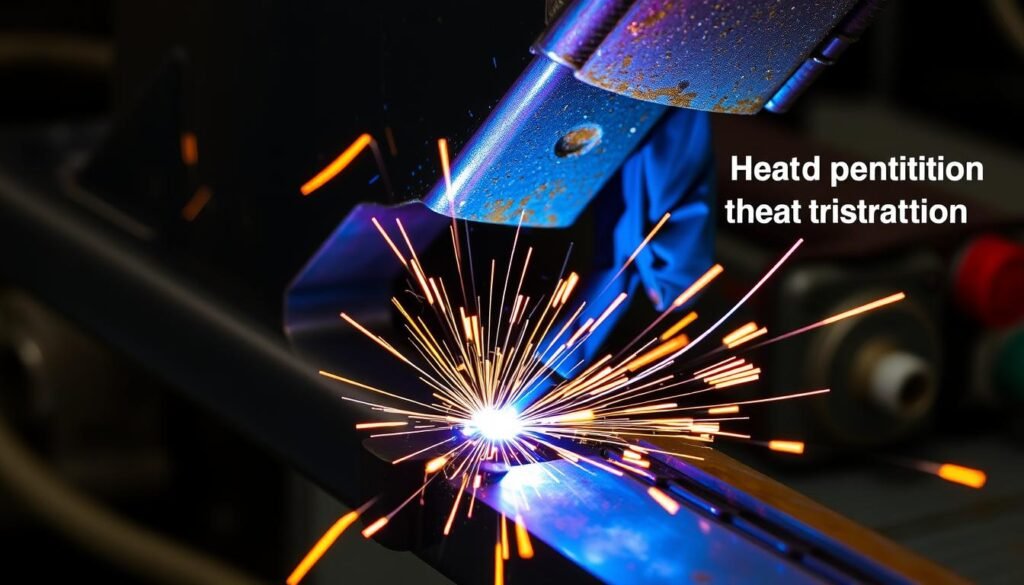Welding steel to aluminum is a big challenge in metal work today. Engineers and makers face the hard task of joining these two metals. They need special skills and knowledge to overcome the problems.
Joining steel and aluminum needs careful work and new tech. The metals are very different, making welding hard. Experts use special ways to link these metals together.
Welding teams know that usual methods won’t work for steel and aluminum. Their structures and how they react to heat make strong bonds hard to achieve.
Key Takeaways
- Steel-aluminum welding requires specialized techniques
- Traditional welding methods are ineffective for dissimilar metals
- Advanced technological approaches are essential
- Metallurgical differences create significant joining challenges
- Professional expertise is crucial in successful metal joining
Understanding the Challenges of Joining Different Metals
Metallurgy faces big challenges when trying to join metals like steel and aluminum. Their different properties make it hard for welders and engineers.
Welding different metals needs a deep understanding of their basics. The success of joining metals depends on key factors. These factors greatly affect the final product’s strength.
Physical Properties of Steel and Aluminum
Steel and aluminum have different physical properties. This makes joining them tough. The main differences are:
- Electrical conductivity variations
- Different crystalline structures
- Distinct mechanical strengths
- Varying chemical compositions
Melting Point Differences
The melting points of these metals are a big challenge. Aluminum melts at about 1,221°F. Steel needs temperatures around 2,500°F.
| Metal | Melting Point | Thermal Conductivity |
|---|---|---|
| Aluminum | 1,221°F | 138 W/mK |
| Steel | 2,500°F | 43 W/mK |
Thermal Expansion Considerations
Thermal expansion is another big problem in metal joining. The coefficient of thermal expansion differs substantially between steel and aluminum. This can cause stress and failure in welded joints.
“Understanding thermal dynamics is crucial in successful metal joining techniques” – Advanced Metallurgy Journal
These differences show how hard it is to join steel and aluminum. It needs special techniques and advanced tech.
Does Steel Weld to Aluminum: The Basic Facts
Welding steel to aluminum is a big challenge in metal work. The two metals don’t mix well because of their different properties. Experts in welding face tough tasks when trying to join them.
The main problem is the intermetallic compounds that form. These compounds are weak and can break easily. When the metals get hot, they react in ways that make the joint weak.
- Extreme differences in thermal properties
- Significant melting point variations
- Chemical reactivity between metals
- Potential for structural weakness
“Successful steel-aluminum welding requires advanced understanding of metallurgical principles and sophisticated joining techniques.” – Advanced Materials Engineering Journal
Experts have found key factors that affect welding steel and aluminum:
| Metal Property | Steel Characteristics | Aluminum Characteristics |
|---|---|---|
| Melting Point | 1,370-1,510°C | 660°C |
| Thermal Conductivity | 50.2 W/mK | 237 W/mK |
| Electrical Resistivity | 0.142 µΩ⋅m | 0.0282 µΩ⋅m |
New welding methods like friction stir welding and cold metal transfer help. These techniques reduce the formation of weak compounds. They offer better ways to join the metals.
Common Methods for Joining Steel and Aluminum
Welding steel and aluminum is tricky because they are different metals. Engineers have found new ways to join them. These methods help solve the problems caused by their differences.
Many new technologies have been developed to join steel and aluminum well:
- Friction stir welding provides a solid-state joining process
- Cold metal transfer enables precise metal deposition
- Resistance spot welding offers quick connection methods
Friction Stir Welding: A Solid-State Solution
Friction stir welding is a new way to join metals. It uses a tool that spins to heat the metal through friction. This method creates a strong bond without melting the metal. The process generates minimal metallurgical changes, which helps avoid weak spots.
Cold Metal Transfer: Precision Joining
Cold metal transfer is a new method for joining steel and aluminum. It uses little heat to join the metals. This technique helps avoid defects and keeps the material strong.
Resistance Spot Welding: Quick and Efficient
Resistance spot welding is fast for joining metals in cars and factories. It uses electricity and pressure to make strong bonds between steel and aluminum.
“The key to successful metal joining lies in understanding each technique’s unique capabilities.” – Manufacturing Engineering Expert
These new joining methods show great promise. They help solve old welding problems. This opens up new areas in advanced manufacturing and engineering.
Advanced Technologies in Steel-Aluminum Welding
The world of metal joining has seen big changes, especially in steel-aluminum welding. Researchers and engineers are exploring new ways to join metals. They aim to solve old problems with new techniques.
Laser welding is a key innovation. It makes strong, clean welds with little damage to the metal. This method is great for working with different metals like steel and aluminum.
- Laser welding offers unprecedented precision
- Minimizes material distortion
- Reduces overall production time
Hybrid welding is another big step forward. It combines different welding methods to get the best results. Ultrasonic welding is exciting because it uses vibrations to join metals without melting them.
“The future of metal joining lies in our ability to merge different technologies seamlessly.” – Advanced Manufacturing Research Institute
Modern hybrid welding tackles big challenges in joining steel and aluminum:
- Overcoming metallurgical incompatibilities
- Reducing intermetallic compound formation
- Improving overall joint strength
These new technologies are changing how we make things in cars, planes, and factories. As research keeps going, we’ll see even better ways to weld steel and aluminum.
Preventing Galvanic Corrosion in Steel-Aluminum Joints
Joining steel and aluminum is a big challenge for engineers. They must stop galvanic corrosion. This happens when two different metals touch, speeding up metal wear.
Understanding the Galvanic Series
The galvanic series lists metals by their electrical potential. Steel and aluminum are far apart in this list. This makes corrosion more likely when they’re together.
- Aluminum is more anodic (reactive) in the galvanic series
- Steel is more cathodic (noble) in comparison
- Contact between these metals accelerates corrosion rates
Protective Measures and Coatings
Stopping corrosion is key for steel-aluminum joints. Coatings can block direct contact between metals.
| Coating Type | Corrosion Protection Level | Recommended Applications |
|---|---|---|
| Epoxy Primers | High | Automotive and aerospace |
| Zinc-Rich Coatings | Moderate to High | Structural and marine environments |
| Ceramic Coatings | Very High | High-stress industrial applications |
Best Practices for Corrosion Prevention
Using smart strategies can lower corrosion risk between steel and aluminum.
- Use electrical isolation barriers
- Apply specialized anti-corrosion coatings
- Select compatible metal interface materials
- Regular inspection and maintenance
“Preventing galvanic corrosion requires proactive engineering and careful material selection.” – Corrosion Engineering Institute
Knowing and using the right ways to prevent corrosion can make steel-aluminum joints last longer in important uses.
Applications in Automotive and Aerospace Industries
Steel-aluminum joining technologies are changing how we make cars and planes. They help engineers build stronger, lighter vehicles and aircraft. This makes them more fuel-efficient and lighter, without losing strength.

The car industry is quickly adopting these new ways of joining metals. Car makers use steel-aluminum connections to make cars that use less fuel and are better for the environment.
- Reduces vehicle weight by up to 30%
- Improves overall fuel efficiency
- Enhances structural performance
- Enables complex design possibilities
In aerospace, these welding methods are also key. Aerospace engineers use them to make parts that are both light and strong. These parts can handle the tough conditions of space travel.
| Industry | Weight Reduction | Performance Impact |
|---|---|---|
| Automotive | 15-30% | Improved Fuel Economy |
| Aerospace | 20-40% | Enhanced Operational Range |
“Lightweight construction is not just about reducing weight, but optimizing performance across critical industries.” – Aerospace Engineering Journal
By using advanced welding, car and plane makers can create better, more eco-friendly vehicles. This helps solve big problems in transportation worldwide.
Essential Tools and Equipment for Steel-Aluminum Joining
Welding steel and aluminum needs special tools and careful prep. Pros must pick the right gear for strong, reliable bonds between these metals.
Choosing the right welding equipment is key. It depends on steel and aluminum’s unique properties. The right tools can mean the difference between a weak or strong joint.
Welding Machines and Power Sources
Choosing the right welding power sources is crucial. Modern machines have special settings for these metals. They help manage heat better.
- Pulse MIG welders with advanced control systems
- Inverter-based power sources with precise heat management
- Digital welding machines with metal-specific programming
Specialized Filler Materials
Filler materials are key for strong bonds. Welders need specific alloys to join these metals.
- Silicon bronze filler wires
- Aluminum-silicon alloy rods
- Nickel-based transition layers
Safety Equipment Requirements
Wearing the right safety gear is a must. It keeps you safe and ensures quality work.
“The right safety equipment is as important as the welding technique itself.” – Professional Welding Association
- High-performance welding helmets with advanced lens technology
- Heat-resistant gloves with enhanced dexterity
- Flame-retardant protective clothing
- Respiratory protection with metal-specific filters
Investing in quality welding equipment and safety gear is essential for successful steel-aluminum joining operations.
Common Mistakes to Avoid When Joining Steel and Aluminum
Welding steel to aluminum is tricky and can lead to big mistakes if you don’t know what you’re doing. Welders need to understand how these metals interact to make strong joints.

Knowing what can go wrong is key to making good welds between these metals. Focus on:
- Keeping the temperature right during welding
- Picking the right materials
- Preparing the joint well
When you join steel and aluminum, you face big risks because they don’t mix well. Welders should watch out for a few big mistakes:
- Not cleaning the surface well enough
- Not considering how they expand when heated
- Using the wrong welding methods
“Proper preparation is 90% of successful welding between dissimilar metals” – Welding Engineering Professionals
Not knowing about the materials can lead to big problems. Here’s a look at some of the challenges:
| Mistake | Potential Consequence | Prevention Strategy |
|---|---|---|
| Poor surface preparation | Weak joint integrity | Thorough surface cleaning |
| Incorrect temperature control | Metallurgical defects | Precise heat management |
| Inappropriate material selection | Premature joint failure | Comprehensive metallurgical analysis |
Welders need to understand how to choose materials and prepare joints carefully. Spending time learning about metal interactions can save you from expensive mistakes and keep structures strong.
Conclusion
The journey of steel-aluminum welding is a big step forward in modern manufacturing. New technologies are making it possible to join metals in ways we never thought possible. The car and plane industries are leading the way with new ways to connect these metals.
New methods are making metal connections stronger, lighter, and more efficient. Technologies like friction stir welding and cold metal transfer are changing the game. These methods are also making these connections more reliable and affordable.
Researchers at universities and labs are working hard to improve our understanding of metal interactions. They are creating new techniques that reduce corrosion and increase strength. As they keep working, we can look forward to even more advanced ways to join metals.
The future of steel-aluminum welding is very promising. With more research and innovation, these techniques will help make engineering solutions stronger, lighter, and more sustainable. They will play a big role in many industries.
